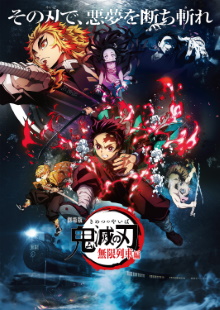So this was the media phenomenon of last year when even our niece came up to us to rave about how great this film is. Due to pandemic conditions it was even the highest grossing film of the year globally. But watching this necessitates actually sitting through the television show itself first which took a while. Overall I have not impressed as this is very much a standard shōnen show made for a younger audience. It may be well be the best shōnen around at the moment but it never aspires to anything more than that and I see nothing outstanding in it at all.
This film directly continues from the ending of the first season of the television show so you really do need to have watched it to know about how Tanjiro became a Demon Slayer out to look for a way to cure his demon sister Nezuko. As ordered, the two together with Zenitsu and Inosuke board a train to support the Flame Hashira Kyōjurō Rengoku where many passengers have disappeared. Their latest enemy, the Lower Rank One, is a subtle one however as all five of them soon fall asleep on the train under the influence of the demon’s blood magic. In their dreams, they are offered their greatest desire to keep them from even wanting to wake up and so Tanjiro is shown a vision of his life before his family was massacred by a demon. We are thus given a rare scene of Nezuko before her demonic transformation. The other characters experience similar fantasies and thus we get some of Rengoku ‘s backstory. Fortunately Tanjiro is wise enough to realize that this is a dream and the real Nezuko remains unaffected in her box.
This basically acts as a two-hour long special episode of the television show itself so I’m perplexed that for the second season they are going to redo this entire arc. I suppose this looks a little better than the show with more CGI effects but for the most part I don’t think there’s much of a difference. It is enjoyable to be able to experience an entire arc in one sitting without extraneous fillers between episodes. Narratively, this arc feels a bit odd as an even more powerful boss pops up out of nowhere after the train demon has been defeated and the real reason for this is to give Rengoku a chance to shine. I understand that the use of the Lotus Eater trope makes this story appealing to some viewers but I’m a little too used to it. I do like how it gives us an extended look at Tanjiro’s family as they are all killed off so early in the show and offering it now is doubly effective as after a whole season we’re now more sympathetic to Tanjiro and Nezuko.
While this works alright as light entertainment, I am underwhelmed given how much of a media phenomenon this was and the rave reviews it received. It’s nice how they have names for the sword techniques and the moves are visually different but in the end it still boils down to raw power and speed which doesn’t make for fights that are actually interesting to me. The values and ideals of the heroes are all thoroughly conventional and childishly simple. In fact this particular series seems to be trying very hard not to subvert anything at all in that the good guys are properly heroic and the bad guys are horrifically evil. In some cases Tanjiro pities some of the demons and tries to end them mercifully but there is no question that any demons who have already killed humans must be destroyed. It is kind of surprising how gory some of the demon inflicted violence can be and they’re not kidding about the demons massacring humans. I suppose this is now considered acceptable for a kid’s show because in the end this is a kid’s show with deliberately juvenile looking protagonists and a straightforward and hence conservative morality.
Perhaps one of the most surprising things about this show is how much of a throwback it feels like by Western standards and yet it seems immensely popular in Asia. The three main characters are all boys and the female characters are all consigned to fairly standard gender roles, the moral values are the usual old-fashioned ones and there is not even the slightest hint of LGBT representation. It would be impossible for a children’s show like this to be made in the US today and shows like the ones being made in the US seem to be still unacceptable in Japan. For example in the newest version of He-Man and the Masters of the Universe, Teela is actually the most important character. As for this series itself, I don’t see anything appealing to me at all in it so I won’t be watching the rest of the television show.
